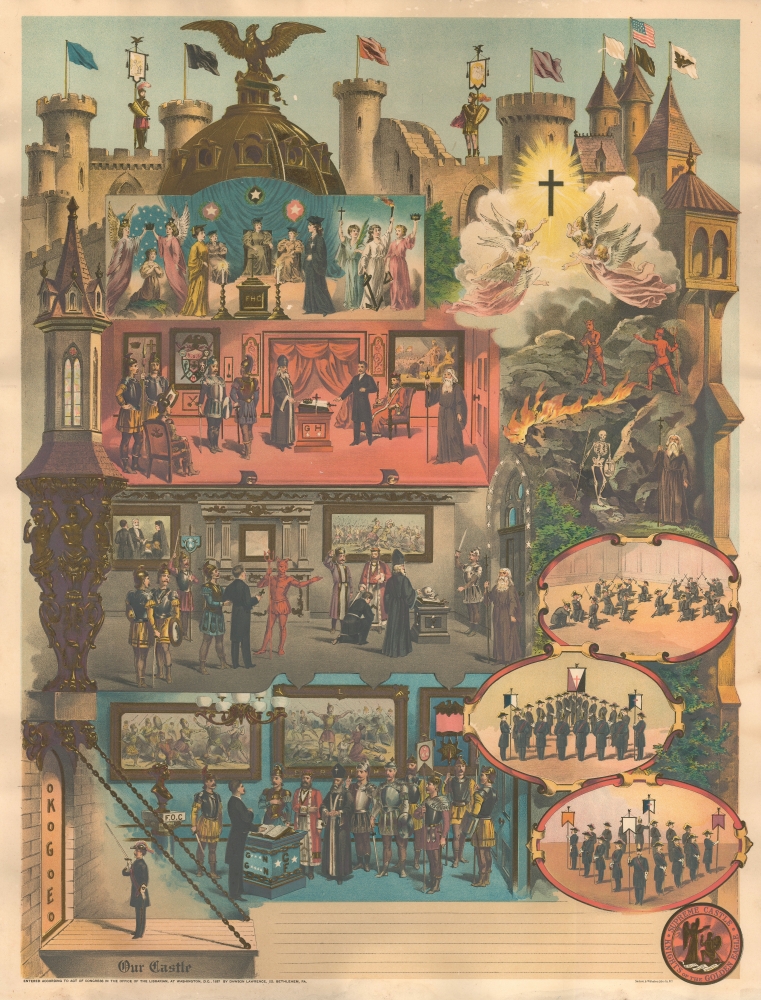1897 Lawrence Broadside, Knights of the Golden Eagle Fraternal Order
KnightsGoldenEagle-sackettwilhelms-1897
Title
1897 (dated) 25.5 x 19.5 in (64.77 x 49.53 cm)
Description
A Closer Look
This striking broadside contains complex allegorical imagery related to the fraternal order, heavily influenced by Christian symbolism, including references to the Crusades. The broadside depicts rituals taking place in several levels of the castle, with the different levels representing the three degrees in the order. The levels of the castle parallel a struggle between good and evil, and relies heavily on Crusader imagery. At the bottom three levels, paintings on the walls behind the figures reinforce the concept of battles, both literal and figurative, while at right are additional depictions of group rituals, likely for initiates.Abbreviations on several altars on the various levels refer to values of the Knights of the Golden Eagle and associated fraternal orders like the Odd Fellows (such as 'F.H.C.' for fidelity, honor, charity). On the top level of the castle are a group of women engaged in rituals, likely meant to represent the female auxiliaries of the Knights, called the Ladies of the Golden Eagle. Although Christian imagery predominates, atop the castle are references to the American Republic, including the American flag, a flag with an eagle, and the dome on top of the castle with an eagle.
Knights of the Golden Eagle
The Knights of the Golden Eagle was a fraternal organization founded in Baltimore, Maryland, in 1873. It was initially established as a mutual aid society, offering support such as insurance benefits, funeral assistance, and camaraderie to its members, many of whom were working-class men. The order blended fraternal ritual with a chivalric theme, drawing inspiration from medieval knights and emphasizing virtues like fidelity, valor, and charity. Structurally, it was organized into local 'Castles,' regional 'Grand Castles,' and a national 'Supreme Castle.' Membership was restricted to Christian men who pledged to uphold moral conduct and mutual assistance. At its height in the late 19th and early 20th centuries, the Knights of the Golden Eagle had a significant presence, particularly in the Mid-Atlantic states, but like many fraternal groups of the era, it declined sharply after World War I (1914 - 1918), with its last bastions being among the working-class miners and steelworkers of Eastern Pennsylvania. It was defunct by the 1960s.Chromolithography
Chromolithography is a color lithographic technique developed in the mid-19th century. The process involved using multiple lithographic stones, one for each color, to yield a rich composite effect. Oftentimes, the process would start with a black basecoat upon which subsequent colors were layered. Some chromolithographs used 30 or more separate lithographic stones to achieve the desired effect. Chromolithograph color could also be effectively blended for even more dramatic results. The process became extremely popular in the late 19th and early 20th centuries, when it emerged as the dominant method of color printing. The vivid color chromolithography produced made it exceptionally effective for advertising and propaganda imagery.Publication History and Census
This broadside was copyrighted to Dawson Lawrence of South Bethlehem, Pennsylvania, likely its designer, in 1897, and was printed by Sackett and Wilhelms. It is quite rare, only being noted among the holdings of the American Antiquarian Society and Williams College in the OCLC and with minimal market history.CartographerS
Dawson Lawrence (fl. c. 1890 - 1920), in one case as 'Dawson Lawrence Co.,' was a civic leader based in South Bethlehem, Pennsylvania, in the late 19th and early 20th century. Little is known of his early life, but by the 1890s he was active in fraternal and labor organizations, including the Masons, Junior Order of United American Mechanics, and Knights of the Golden Eagle. City directories from the end of the 19th century list him as a traveling salesman, but by the end of the century he was noted as the president of the 'Equitable Building and Loan Association,' which was likely associated with a fraternal order. Three known works were copyrighted by him, all chromolithographic broadsides for fraternal organizations. More by this mapmaker...
Sackett and Wilhelms (c. 1887 - 1945), often as the Sackett and Wilhelms Lithographing and Printing Company, was a lithographic printer based in New York City, and more specifically in Brooklyn. The firm was best known for their printing of chromolithographic illustrations for the satirical magazine Judge, but they also produced broadsides, maps, and books, and were especially active in producing posters to support the U.S. war effort in the First World War. The company's printshop in Brooklyn was notable for being the home to the world's first modern air-conditioning system, designed by Willis Carrier (1876 - 1950), working at the time for the Buffalo Forge Company. Because of humidity in the summertime, paper would shrink and expand throughout the day, causing the colored inks, applied one at a time, to be misaligned. Desperate for a solution, Sackett and Wilhelms turned to Buffalo Forge, who tasked their promising young engineer Carrier with finding a solution, leading him to devise methods for controlling humidity in addition to cooling air. Learn More...

